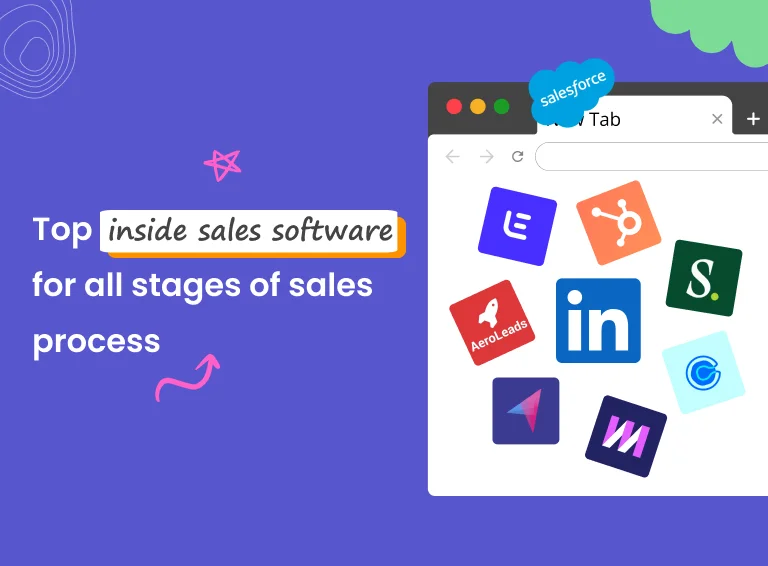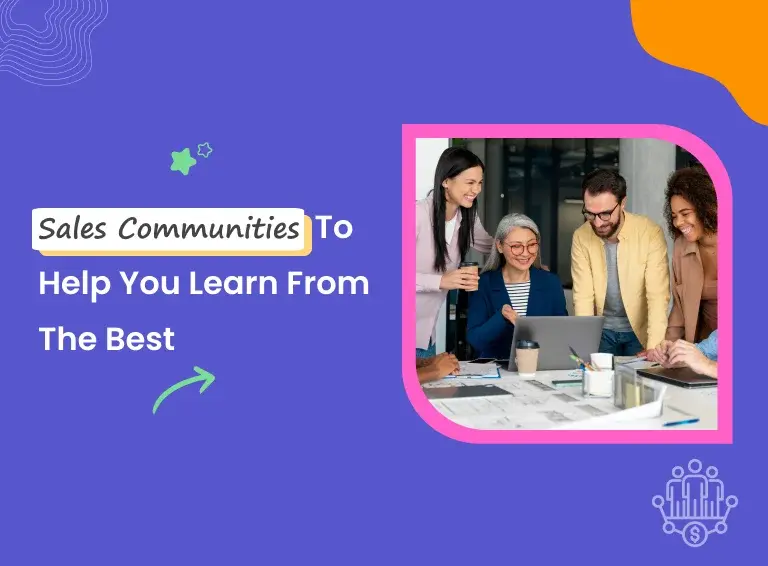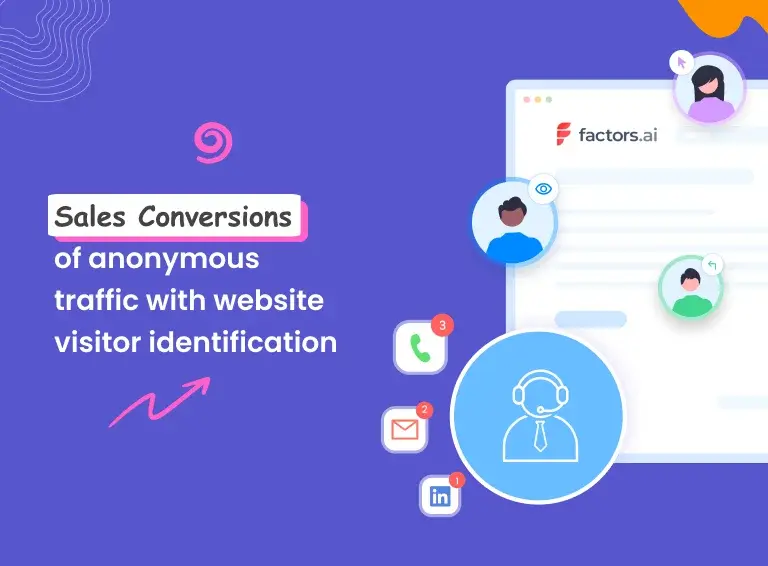A good salesperson, we’ve been told, is someone who ‘could sell sand at the beach.’ But when you think about it, that’s hardly the mark of a good salesperson. A good salesperson would put their time and skills to much better use – because sales, at its core, is about solving a customer’s problem.
Good salespersons are those who focus on prospects who *actually* need what they’re selling.
Great salespersons are those who sell to people they’ve already sold to.
Here’s why: the probability of selling to an existing customer is 60-70% while that of selling to a new one is 5-20%. The fastest-growing companies and the best performing salespersons are those who focus on growing revenues from existing customers. Simply because it costs twice as much to acquire a new customer than it does to sell to an existing customer.
Enter upselling.
The word may conjure images of greedy salespersons trying to sell you stuff you don’t need.
But upselling is far from a bad word.
Done right, it can help you deliver real value to your customers, build stronger relationships that help you and your customers grow together.
Let’s back up a bit to understand what exactly upselling is, and how it differs from cross-selling and downselling.
1. What Is Upselling?
Upselling is simply offering an upgraded plan of the product or service the customer has already bought.
Would you like to make that a Large for just 50 cents?
Our special smoked cheese on your pizza?
These basic upsell strategies that you encounter at McDonald’s and Domino’s add hundreds or thousands to their revenue every single day.
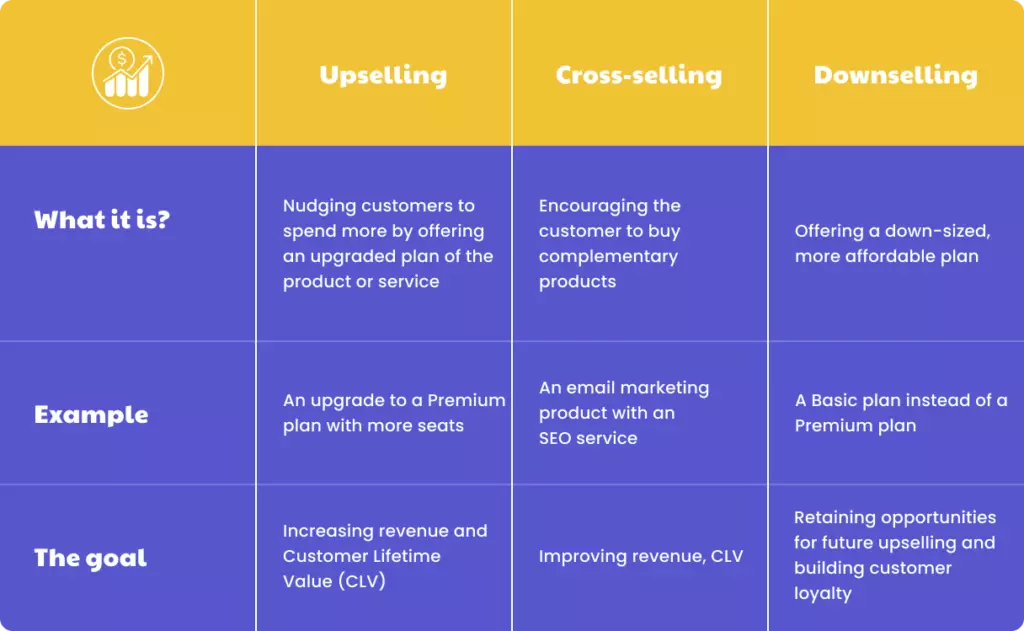
SAAS Companies Rely on These Major Metrics To Build Upselling Strategies:
- Customer Acquisition Cost (CAC): The costs incurred to acquire a customer.
- Lifetime Value (LTV): The prediction of the value a customer could bring over time, an important metric if you're focusing on getting more enterprise level deals.
- Net Revenue Retention Rate: The percentage of value retained from existing customers in a particular time period.
- Expansion Potential: The potential of customers buying more seats from you.
- Customer churn: The percentage of customers that stopped using the product/service.
- Average Revenue Per User: The average revenue generated by each user.
- CAC Payback period: The time it takes to recover the CAC.
Upselling Works
Besides the higher chance of conversions, the other big benefit of upselling is the lowered CAC payback time.
The 2021 SaaS benchmarking survey found that the median customer acquisition costs (CAC) needed to acquire $1 annual contract value (ACV) for new customers was $1.67 – meaning that it would take more than a year to earn back the CAC.
In comparison, the median CAC per $1 of upsells was only $0.28, about 38% of the cost to acquire each new customer dollar – meaning that the CAC payback period was only about four months!
It’s easy to see how upselling positively impacts a company’s profitability by improving conversions, reducing CAC payback time, and increasing LTV.
2. How to Upsell in SaaS: Designing Your SaaS Upselling Strategy
There are two paths to design your upselling strategy.
Self-serve: Integrating upsell options within the product and the website.
Salesperson-driven: Leveraging relationships with customers and approaching them with a personalized approach based on usage data, company/team background, etc.
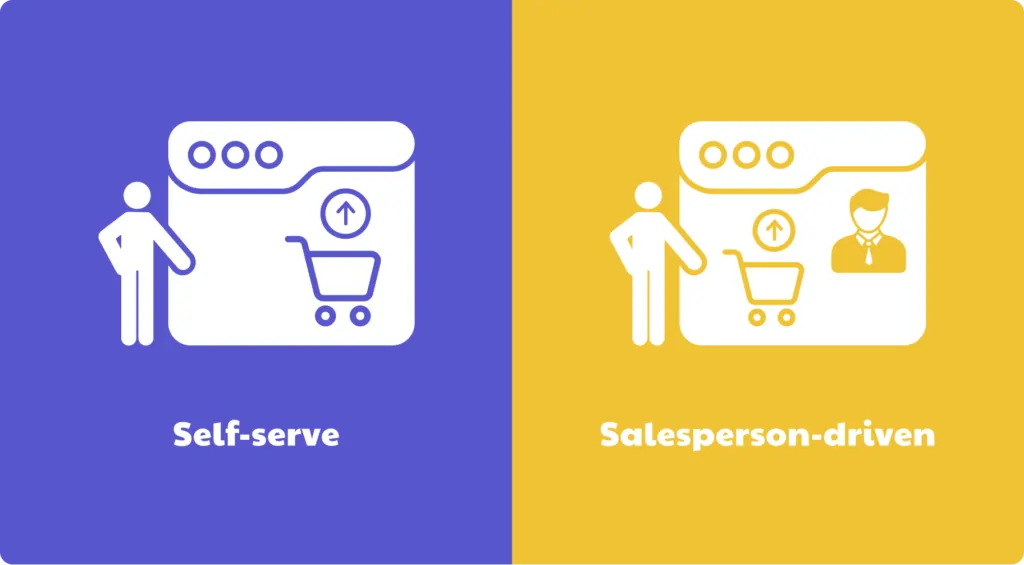
Let’s look at these in detail.
A. Self-Serve: Use In-Product Nudges to Upsell
1. Gate by Usage
Design your product so users get a chance to first discover what an upsell could give them. As a customer nears the product's usage limits, include in-product nudges to upgrade the plan to unlock more usage. That way, the customers see the value of the upsell, and are convinced of the need to upgrade. This also works in the favour of salespeople because it makes them sound less pushy.
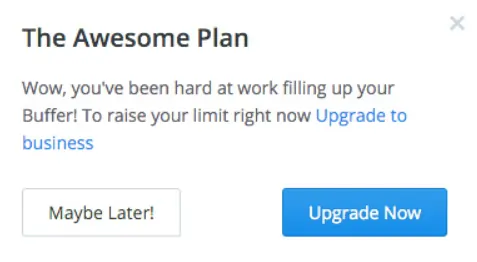
(Source: Buffer)
Spotify does this by integrating the premium ‘skip’ feature into the free user experience. It allows users to skip six songs per hour, after which they’re prompted to upgrade. This way, users discover the feature in context and experience how it would benefit them. Though strictly not an upsell, this approach can be applied to selling SaaS.
As Joel York, CMO of Shelf puts it. “Your customer must have the need, but it must also see the value, and not necessarily in that order. You should design your SaaS product so that your customer naturally discovers and digests new capabilities just-in-time as their needs grow. Done well, this not only maximizes upgrades and upsells, it streamlines usability and simplifies adoption.”
2. Offer Recommendations
A McKinsey study attributes 35% of Amazon’s yearly revenue to its personalized product recommendations. In the SaaS context, you can use your most common usage patterns to create recommended price bundles for entry, mid, and pro levels. The bundles look attractive because you're not forcing them to upgrade to a bigger plan with a zillion more features, rather you're asking them to pay a little bit more for the additional value that customers like them need anyway. This way, customers have a defined tech-stack pathway as they grow.
3. Use Banners, Pop-Ups, and the Chat Option in Your Product
Make your upsell visible: Offer it everywhere it makes sense. For instance, on your product pages, or as a CTA when users log in.
Delighted makes an upsell visible with a banner and a tooltip to explain exactly what the premium Trends feature does.
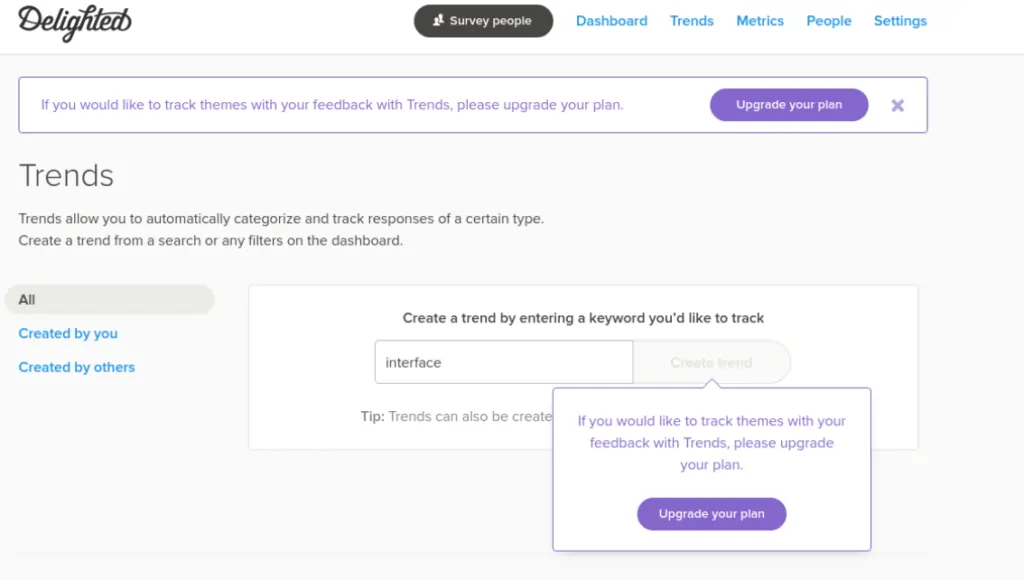
If you don’t want to wait for users to click on premium features, you can also position them alongside commonly-used available features, like Harvest does with its ‘Import’ feature.
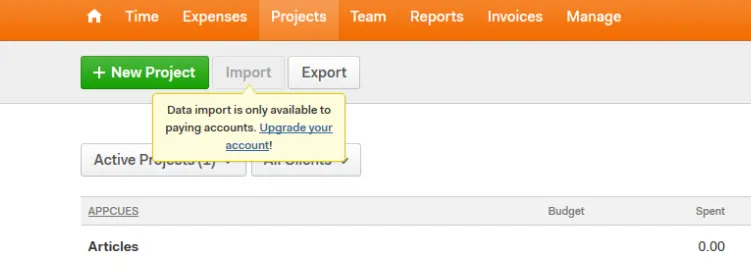
You can also use a chatbot to highlight premium features that could prompt users to upgrade like Airtable does in the example below.
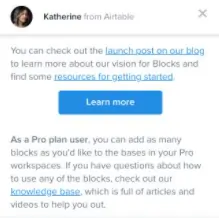
B. Salesperson-Driven Upselling Approach
No matter how effective your in-product upselling strategies are, there’s no denying the power of personalized selling.
1. Focus On Building and Nurturing Your Relationship With Customers:
If you only talk to customers for transactional purposes, they won’t trust you when you're pitching your upsell. Make time for regular check-ins with your customers to understand what their experience has been like, what roadblocks they’re facing, how they can unlock your product’s full potential, and recommend the best or better -personalized solutions for them. You have to remember that your product is one of many that customers use. It’s unlikely that they will remember – or even have the time to – reach out if they have any problems or needs.
a) Leverage memories, milestones, and accomplishments. Time your upsell according to your customer’s journey with you and the product. This could be a call/email when your customer completes X months with your product, or Y tasks, or Z engaged users. Key company milestones (funding, new launches, key hires, etc.) are also great opportunities to introduce an upsell.
b) Personalize your interaction and show them exactly how your upsell adds value in the context of their use case. So, if you’re pitching an upsell closely following a fundraise, you could show them how your upgrade could provide more visibility into new marketing initiatives, target more subscribers, etc. If you’re approaching them after a team expansion, pitch the upsell with a plan that is personalized for their new team.
c) Add an element of urgency. By linking a time-bound upsell to a milestone, you could leverage your customer’s sense of accomplishment.
What does this look like? Let’s say you sell an email automation SaaS. Here’s what your personalized upsell email could say:
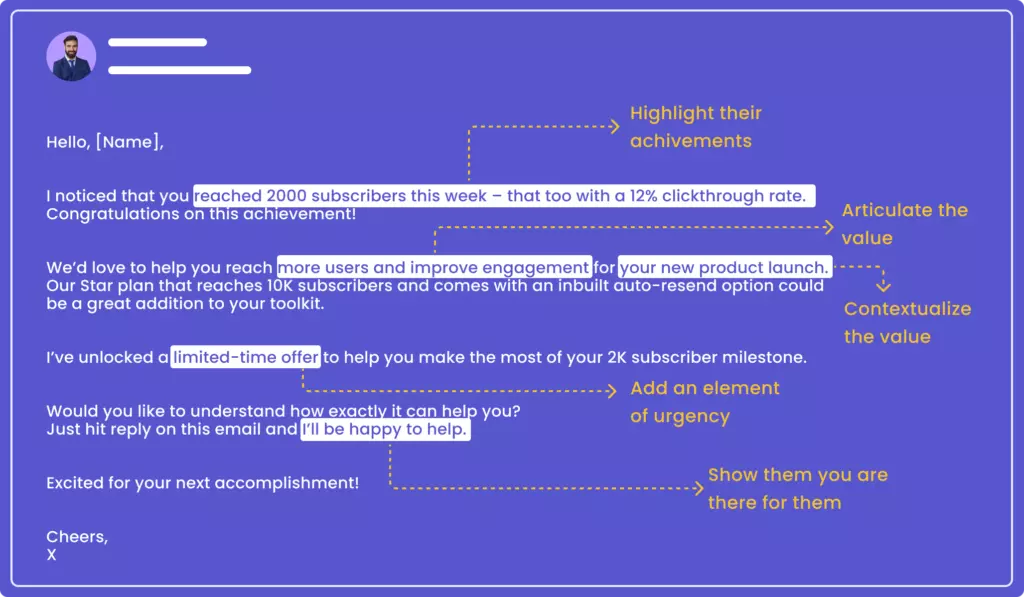
2. Customize the Upsell
Talk to your customers to understand exactly what features unlock maximum value for them. You could use this information to offer customized bundles that let your customers combine a basic plan with X number of premium features.
Or you could offer usage-based upselling or metered pricing where you offer a combination of tiered pricing plus overage fees. This gives them the option to pick a base plan that makes most financial sense for them, while also giving them the flexibility to increase their usage only when they need it – say specific times of the year, or for a few users.
TextMarks, a business SMS platform charges a base subscription for each of their plans. Users can pay for overage instead of upgrading their plans.
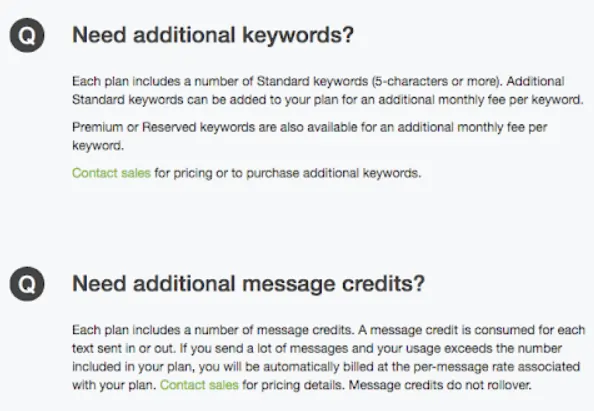
(Source: TextMarks)
3. Offer Pilot Programs
A pilot program could, for example, allow a 10-user team to use a premium offering for say, 30 days, at the cost of one user. The benefits of such a program are easy to see:
a) You make internal champions out of your end-users,
b) Buyers can first understand how valuable the tool is for the team, and use that to measure value for the company.
4. Upsell as Part of a Solution to a Customer’s Specific Problem
Use your customer’s support queries as an entry point for an upsell opportunity. For instance, you could respond to a Support query with a personalized email and a customized offer that helps solve their problem.
Here’s an example. Suppose your email marketing product has a feature (video blocks) that your customers are unable to use on their current plan. You could use this customer problem to pitch a customized upsell.
[Re: Unable to add video blocks]
Hello [Name],
I just learned that you’re having some trouble with adding video blocks to your emails. Video blocks are an advanced feature on our product, but I’d love to talk to see how we can help you use this to design emails with higher CTRs.
Could we speak today to understand your requirements and how I can integrate this into your current plan?
Cheers,
X
5. Offer Referrals
Reach out to customers after a referral to pitch an upsell with a ‘product ambassador’ or ‘star user’ discount.
Airtable has a referral program that gives users credit that they can use to upgrade to a premium plan.
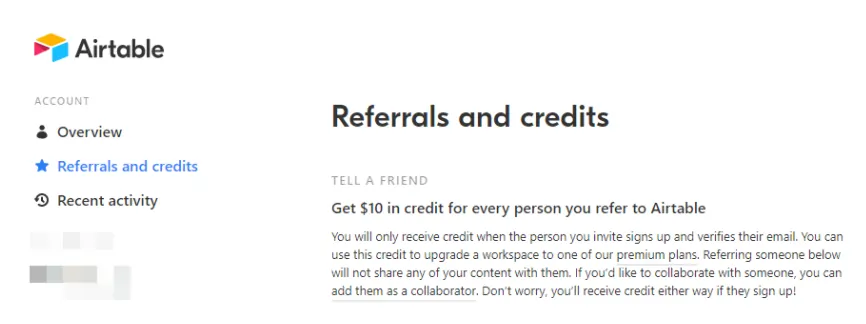
By thoughtfully pricing your referral credits based on the pricing of your upgraded plans, you can nudge your customers to make the most of their referral credits to upgrade.
6. Define a Top-Down and Bottom-To-Top Approach
Design your upselling approach to
- Introduce premium features to employees who will use them in their day-to-day operations. This way, you can convert them into internal product champions.
- Showcase the value that this adoption at the end-user level is translating into (reduced man-hours, increased productivity, more tickets closed, etc. ) to the top management.
Then, you have the backing of the employees who have used and a measure of the value derived from your product, to pitch the best financial offer to the management without relying on heavy discounts.
3. How To Identify a SAAS Upsell Opportunity
Upselling, at its core, is a customer happiness and satisfaction strategy. It depends on knowing how engaged your customers are. And for this, you need the right systems, tools, and data to segment your customers, and identify engaged and happy customers.
A) Finding a Self-Serve Upsell Opportunity
Here are a few data-based signs a customer is ready for an upsell, when you want to integrate your upsell into the product:
- Product analytics that notify you when users are approaching or exceeding usage limits
- Customer visits to FAQs or knowledge-base pages related to premium features
- Chats or support requests within the app or on the product website
B) Finding a Salesperson-Led Upsell Opportunity: How Do You Find the Right Customers?
Step 1. Map the upsell potential by tracing every conversation you/someone from your company has had with the prospect.
- Find upsell indicators. These are actions by customers that your team will be able to track within the product or your website through the cookies in their system. Some of them include – customers reaching their usage limits, the amount of time being spent on premium feature website pages, requests for solutions with the support team, etc.
- Use your routine customer check-ins to discover information such as:
- The number of people in their team, the team’s budget and goals, the other tools being used, their usage/license timelines at the end-user level.
- The company size, funding, and expansion plans.
- Use your research to assess the expansion potential of customers based on their team size, the number of ICP roles, their budgets, and goals.
- Check chats/support requests within your product to see what engaged/ ICP users are looking for. Talk to your support team to gather the information you need (engaged users, common queries, and requests) and use this to customize an upsell.
Step 2. Find out if they’re using your product only for a few members of the team. If that’s the case, you can start the rest of the team on a pilot program so you can show the value of your product for the whole team.
Step 3. The ideal time to pitch to customers is typically after a month or two into the usage. By this time, successfully onboarded users would have discovered their ‘aha’ moments, and engaged long enough to experience what makes your product sticky.
Step 4: Get the product team to do churn analysis to explore pain points, opportunities, and stages at which customers churn so you can do course corrections if needed in your upselling strategies.
💡 You upselling path can look like this: Generate intent→ Convert to opportunity → Position the deal → Offer an upgraded trial → Discuss the finance.
4. Do’s and Don’Ts of Upselling
Do’s
1. Make Regular Check-Ins a Habit
Building an ongoing relationship with your customer. Invest time in regular check-ins and updates to understand their experiences, needs, and problems, instead of reaching out only for transactional purposes.
2. Don’t Make Them an Offer They Have To Refuse
Research what your customers can afford and make it look like they’re getting their money’s worth. How? Keep the end value that your customers get in center focus. Even for your most loyal customers, look to increase the value : price ratio with every upsell.
3. Narrow the Upsell Choices
A study by Bain showed that narrowing choices and minimizing complexity can boost revenues by 5-40% and cut costs by 10-35%. Show your customers the right options for them by personalizing the upsell.
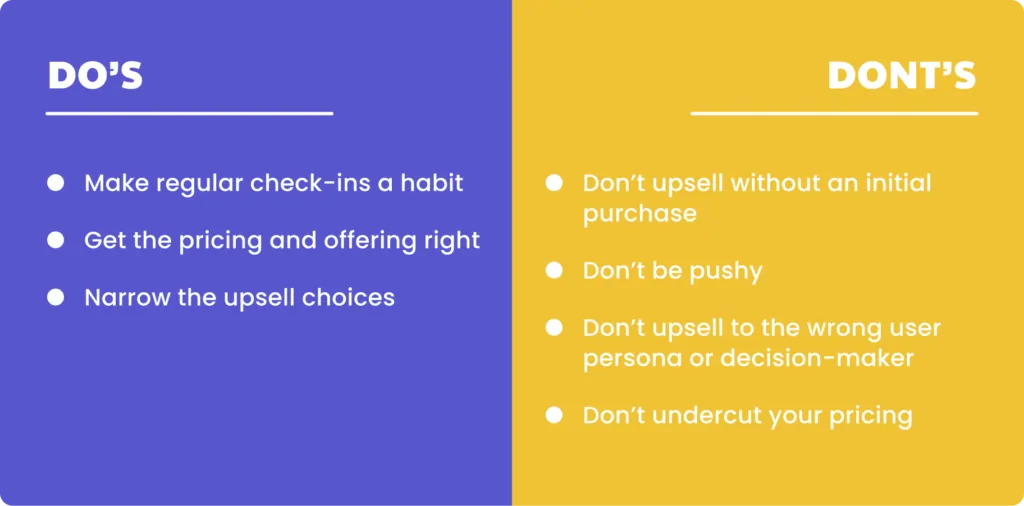
Don'Ts
1. Don’t Upsell Without an Initial Purchase
Though you can use your website or purchase page to prompt an upsell, as a salesperson, don’t approach your customer with an upsell till they’ve made their first purchase and engaged with your product for a while.
On the same lines, don’t talk money till they see the value in your product. Track their adoption and usage, and approach them when you know the exact value you can unlock for them. This in turn helps better position and price the offering.
2. Don’t Be Pushy
Look to help, not sell. Don’t just say – “Buy this premium plan. It is *better* or has more features. ” Contextualize the offer with their goals/use cases to find the exact value (eliminate/simplify/shorten/improve/increase/decrease) they can get.
Remember, no is a valid answer. You can always make the upgrade option self-serve and check back in later with a stronger proposition based on their future usage.
3. Don’t Upsell to the Wrong User Persona or Decision-Maker
Position the usability factors, free trials, and tactical benefits to employees and end-users.
Showcase productivity improvements, financial value, and long-term benefits to the top management.
4. Don’t Undercut Your Pricing
If the customer sees the value, then don’t undervalue your product with excessive discounts. Customize your upsell offer with the right combination of features such that a) your customers have a chance to experience continued value, and b)you have an opportunity to increase MRR without relying on drastic discounts.
Wrapping Up
Even a company with 20% annual growth has a 92% chance of disappearing within just a few years. SaaS businesses need steady and sustained growth to succeed in the current market. Net revenue retention (NRR) has a huge role to play here – it indicates how well you retain the revenue existing customers bring. With a hit-or-miss approach to upselling, companies will struggle to retain and grow revenue from existing customers.
SaaS upselling shouldn’t feel like an elaborate ploy to squeeze revenues out of your customers. By placing the value your customers achieve in center focus, everyone wins: your customers have the perfect software solutions for their business and a relationship they can trust. You have long-standing customers and the possibilities of upsells, and further, account expansion.
To create and execute on a clear upsell path, you as a SaaS business need to:
- Design clear capability-driven and consumption-driven upsell paths within the product
- Use data to
- influence packaging, bundling decisions and design meaningful upsell paths
- identify (and establish) usage and feature adoption patterns for different kinds of users, as well as the signs of an upsell opportunity
- Arm your sales teams with the tools and information they need to identify the right types of customers, customer cohorts, as well as the optimum time to successfully target potential upsells.
We hope this upselling guide is helpful as you go onwards and upwards in your sales journey.

